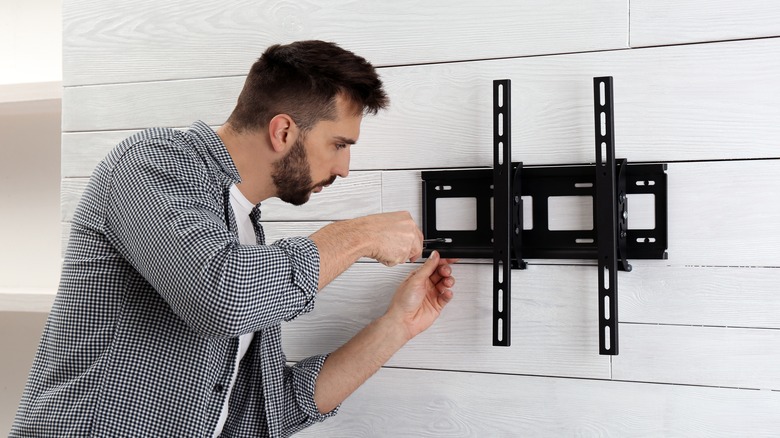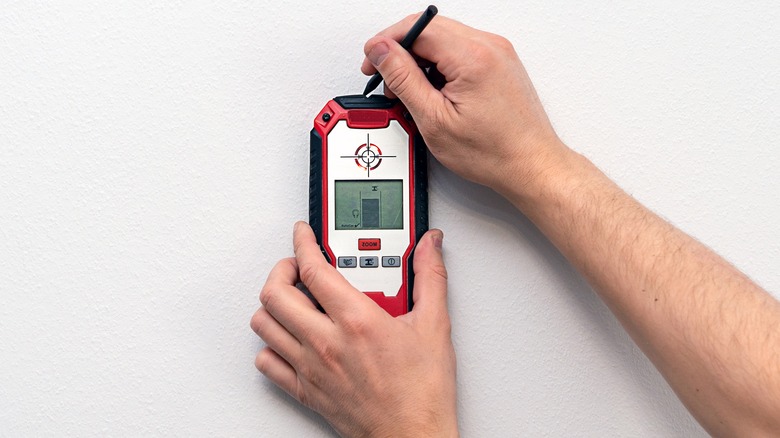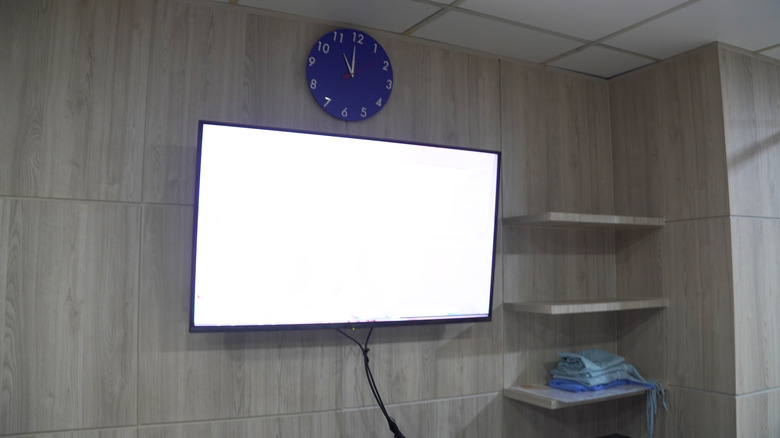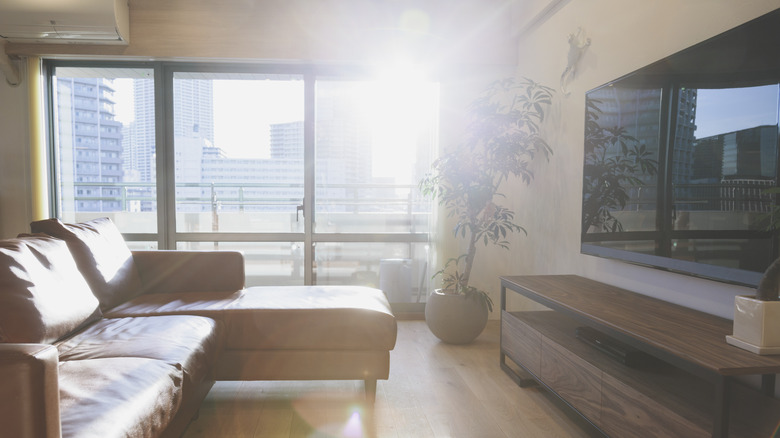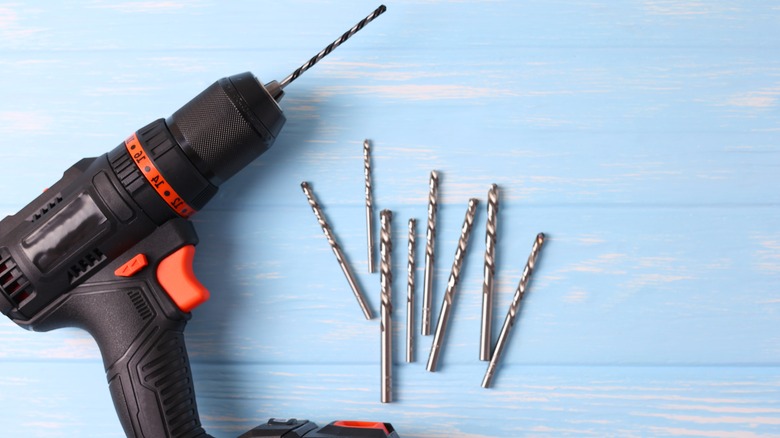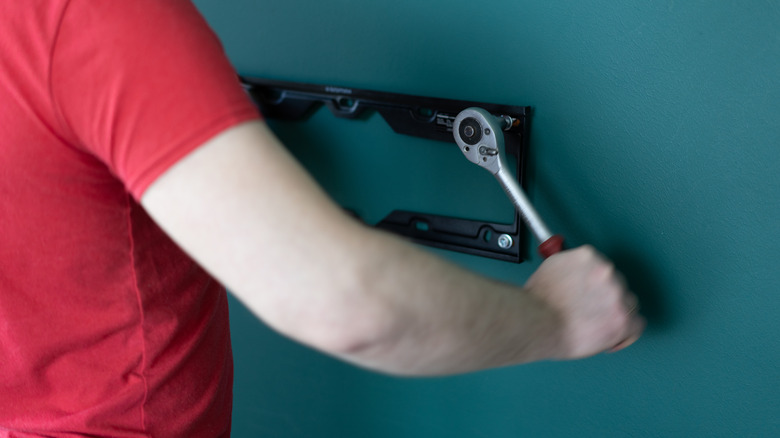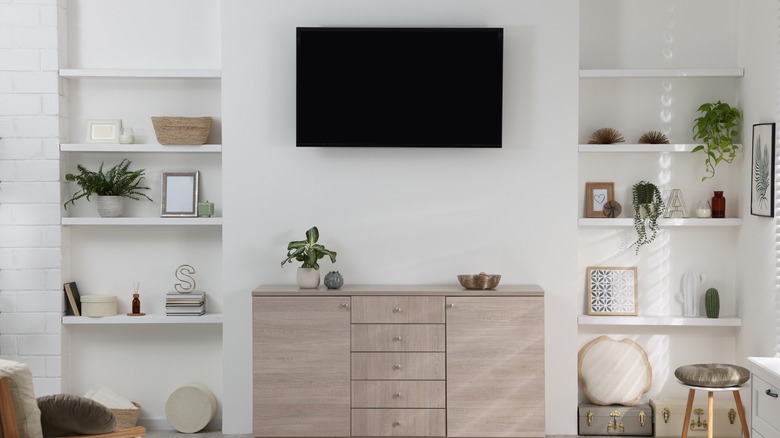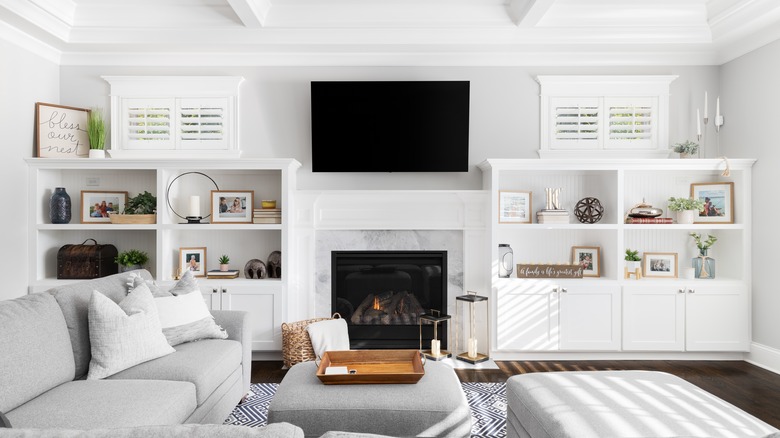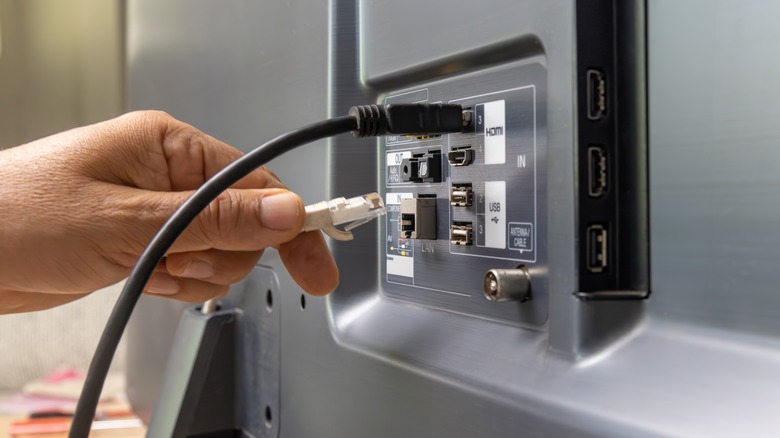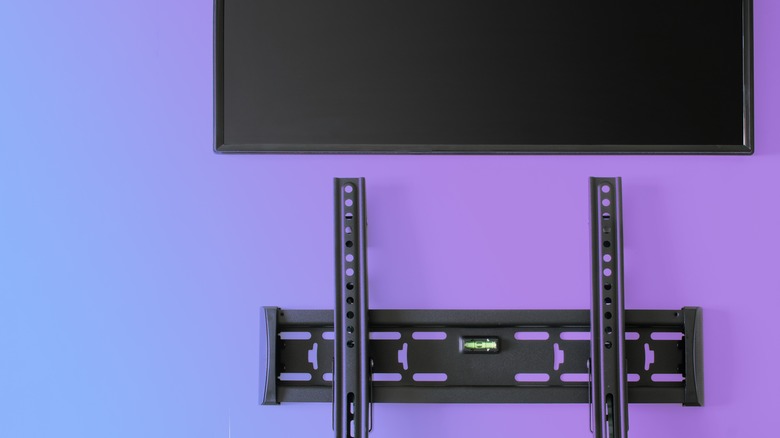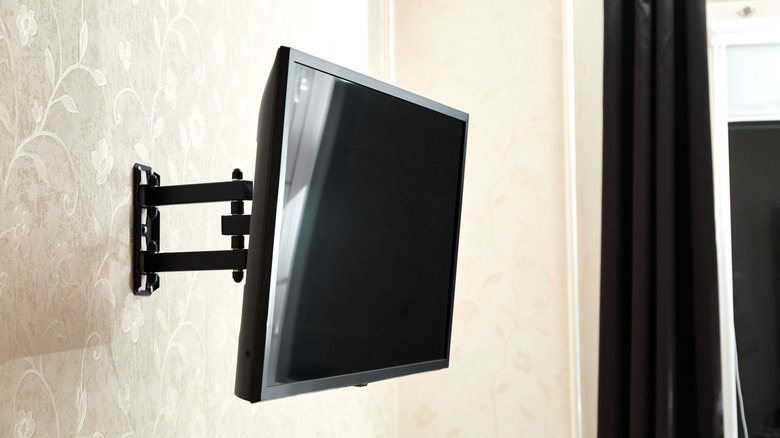10 Mistakes You Might Be Making When Mounting A TV
We may receive a commission on purchases made from links.
When you buy a new TV, you have a very important decision to make: Will you set it on an entertainment stand or take on the far more industrious task of mounting it on a wall? Mounting may require a little extra work, but it has several advantages, especially in terms of saving space.
Mounting your TV frees up floor space and removes the need for a separate stand. You can put something else underneath the TV, which may be preferable to people living in smaller spaces like apartments. It also creates a cleaner, more minimalistic look by keeping cords and wires out of sight. This is especially helpful for people with pets or small children who might try to mess with the television.
Once your TV is mounted, you'll likely enjoy it for years to come. The hardest part is simply getting it up there. There are some common mistakes people tend to make when mounting TVs, especially if they've never done it before. It certainly requires careful preparation so that you don't damage the wall or the television. By being aware of the following pitfalls, you'll feel far more at ease with that expensive piece of equipment securely mounted on your wall.
Not finding a stud
Your house or apartment has vertical wood beams, called studs, running underneath each wall. These studs, spaced equally apart, are essential for the building's structure. They're also helpful if you need to hang heavy items, like a large picture frame or a mounted TV.
When you mount a TV, it's essential that you attach it to a stud. Without this anchor, the screws will only grip drywall, which isn't strong enough to support the weight. Installing a TV without a stud greatly increases the risk of the mount and TV falling at some point. Even if it seems secure, a slight jolt or even a small earthquake could knock it out of place. Not only will this break your TV, but you'll probably wind up with a huge hole in your wall, necessitating substantial repairs. To avoid this, you should have a stud finder handy, like the Dewalt Stud Finder, to locate a stud ahead of time. They're most often 16 inches apart from one another in most walls, but they may be a bit farther apart in larger homes.
Before embarking on this task, you should learn how to properly use a stud finder. It's fairly simple: Hold down the button and move it across the wall until it beeps. This tells you where the stud is and where you should drill.
Hanging the TV too high
For our money, one of the funniest subreddits to follow is r/TVTooHigh. It's genuinely hilarious to see all the unhinged places people have mounted their televisions, often with captions about neck pain from watching a simple football game. It also serves as a good reminder to find the right height for your TV before you begin drilling.
There's no one-size-fits-all solution for determining how high a TV needs to be. It depends on the television's size and how far away the couch will be from it. A good place to start is to have the bottom of the TV at eye level when you're seated. You can mount it a little higher than this, but you'll want to consider a tilted setup for more comfortable viewing.
The last thing you want is for your living room to end up on r/TVTooHigh because your friends think your setup is ridiculous. If you can, get someone to sit on the couch as you test different heights before installing the mount so you can get a second opinion.
Not considering all of the variables
Height is merely one factor to consider before you mount a TV. You don't want to get it up there and realize that your viewing experience will be compromised. For instance, you should ideally place the TV somewhere with easy access to a power outlet. It's possible to install a brand new one onto the wall, but this will require the aid of a professional electrician, as some rewiring will be necessary.
It's also good to avoid placing your television in the direct path of sunlight. If your TV is constantly getting exposed, it can lead to color shifting and overall screen degradation over time. While there are ways to reduce glare on TV screens, such as installing an anti-glare film, avoiding a spot near a window can save you some hassle.
Finally, you want to consider where any extra components will go. You may want a Blu-ray player or gaming console attached to the TV. In this case, it's good to ensure there's enough clearance underneath the TV to add a sturdy shelf for anything you need to have the most optimal viewing experience.
Not having all of the right tools
The last thing you want is to get started with mounting your new TV only to realize you're missing a critical tool. Then you're stuck holding the mount or TV in place while someone else heads to the hardware store to get it. As with any DIY project, you want to ensure you have everything you need before getting started. That includes all of the tools that'll come in handy when installing a TV mount.
As stated previously, a stud finder is crucial for this task. It's also a good idea to have a tape measure – something like the Craftsman Tape Measure – on hand to ensure the TV and mount are centered on the wall for the best look. Speaking of aesthetics, you also want a reliable leveler, such as the Laser Level Line Tool, so that the mount — and the television — aren't crooked. Once you've ensured everything will look correct, you're ready to start drilling.
A good power drill is essential for mounting the TV and other home projects. Also, double-check you have the proper drill bits; the mount's instructions will specify the exact size. If you're mounting on concrete or brick, which is often preferred for outdoor setups, you'll need specialized drill bits and screws. Finally, when you have the mount installed, you're ready to attach the television itself. This typically requires bolts and a socket wrench to secure everything.
Installing the TV and mount by yourself
Even if you consider yourself handy around the home, it's never a good idea to attempt to install a wall mount and television on your own. It's always recommended to have at least one person to help you, particularly when it's time to attach the TV to the mount.
For starters, a second opinion on the TV's placement can ensure it's at the right height and level. If nothing else, you'll definitely need another person when you need to bolt the television to the mount: One person needs to hold the TV in place while the other fastens the bolts with a socket wrench.
At the end of the day, there's no shame in asking for help, whether that means bringing in a friend or hiring a professional to do the installation. You'll naturally be paying more due to labor costs, but if you have any concerns about installing it correctly, it's better to pay a little extra upfront rather than potentially damage the wall and pay more later.
Using the wrong mount
Most modern TVs are designed for wall mounting. However, when in doubt, check to ensure your television adheres to Video Electronics Standards Association (VESA) compatibilities. VESA ensures that monitors and mounts of the same size remain compatible across brands. That means a 55-inch TV should work with any standard mount that supports 55-inch TVs.
Some TVs already come with mounting equipment, in which case you can simply use that. Additionally, some stores provide free (or at least affordable) wall mounting when you purchase certain TVs from them, and in that case, you can sit back and relax while professionals do all the heavy lifting.
If you need to purchase a mount separately, you need to be certain it works for your TV's size and weight. You don't want to risk putting too much strain on the stud and mount by getting incompatible sizes. The mount's weight capacity should be greater than what your TV actually is, just to be safe. The manuals that come with the TV and mount will provide all pertinent information, and you can also look up these details on the manufacturers' websites.
Mounting a TV over a fireplace
Many homes have empty space directly above the fireplace. Therefore, it's understandable that people would look at that empty space and think, "A TV would look great there." Even if it would, you generally don't want to mount a TV above a fireplace.
First, as warned on r/TVTooHigh, the space over a fireplace will almost certainly make your television too high to watch comfortably. There are additional dangers if you actively use your fireplace throughout the winter. Soot coming out of the fireplace and getting blown upward inside your television will hamper the delicate electronics inside. This could cause it to fail years before it should.
Even if you have a gas fireplace where soot isn't an issue, there's still the concern about heat. Overheating is bad for any electronic, which is why you should keep the TV away from any heat source, including sunlight. Plus, if you have an old-school fireplace made up of predominantly brick, it's going to be even more of a hassle to get it mounted in place. Fireplaces often take up a good amount of real estate in a living room, making it tricky to install the television anywhere else. But it's worth getting creative to avoid your brand-new TV failing after only a couple of years.
Overlooking the cables
Given the prevalence of smart TVs (or making TVs smart with a plug-in), your new setup may not require as many cables as in years past. However, you may still need certain cables if you want to connect your television to the internet or hook it up to other devices, like gaming equipment. If that's the case, it's good to plan how to hide these cables before you mount the TV. Otherwise, you could end up with unappealing cables running down your wall.
Fortunately, there are some easy tips and tricks to hide wires from a mounted TV. Cord clips and zip ties are useful for keeping multiple cables together. Depending on the layout of the room, you may be able to work cables into the decor to hide them in plain sight. Another option is a raceway kit, like the D-Line Cord Cover Kit. It attaches to the wall to conceal cables behind a strip.
Anyone feeling creative can turn to Pinterest for inspiration on hiding mounted TV cables. Some people stack books or install an art piece between an entertainment center and the TV to tuck the cords behind.
Failing to properly level the TV
There's an adage every DIYer should be familiar with: measure twice, cut once. It's wise to check everything before drilling to ensure you'll be happy with how your mounted TV turns out in the long run. That means ensuring the mount is leveled before drilling it into the wall. Some mounts come with a level bubble built in, which would theoretically make the job easier. However, even then, it's good to double-check with a separate level to ensure it's perfectly straight along the wall because you never know how accurate the mount's bubble will be.
Even if you measure everything multiple times, when all is said and done, you might still end up with a crooked TV. This requires some digging to determine the culprit. Most often, it's an issue with how the mount was installed, so you may need to take it out and reinstall it. Another possibility is that the hardware securing the mount or TV isn't fully tightened. You may just need to screw some components in a little harder.
It could also result from a misalignment when installing the TV onto the mount. The mount's plating has a litany of holes, and if you put the TV into the wrong holes, it'll appear crooked. Check this and other potential issues first before deciding to remove the mount from the wall.
Failing to read the instructions
This final tip should really go without saying, but it's critical to read the instructions with whatever TV mounting system you get. Even if you've mounted televisions in the past and feel like you have a firm grasp on what you're doing, mounts can differ significantly. You always want to familiarize yourself with a given system to see how it needs to be drilled into the wall and how the TV attaches.
The instructions will also inform you of the specific anchors and screws required. You may think you can cheat a little, but it's vital to get the exact specifications right to avoid damaging the wall or risking the TV falling. Taking a few minutes to read through them can save you hundreds of dollars in repairs in the long run.
Even after a successful TV mount installation, don't throw the instructions away. Keep them in an accessible location because you may need them again if you ever move and need to re-mount your setup.
